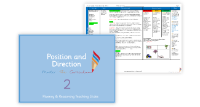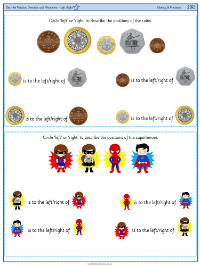Position and direction - Describe position - Planning

Maths Resource Description
In a Year 2 summer term lesson on Position and Direction, students are introduced to the concept of describing position through engaging activities. The lesson utilises a variety of resources such as presentations, worksheets, cones, and Beebots (coding robots), to help students understand and use key positional vocabulary including 'left', 'right', 'forwards', 'backwards', 'position', and 'direction'. Prior to the lesson, students are encouraged to play board games like snakes and ladders and Twister to familiarise themselves with positional language. The lesson starts with a recap of previous learning, particularly focusing on the understanding of 'left' and 'right', as well as the language used to describe quarter and half turns.
The class engages in practical activities, starting with a partner exercise in the playground or school hall. One student marks out a route with cones and uses positional language to guide their partner through it. In group work, students use Beebots to navigate a grid, applying their knowledge of direction to code the robot's movements. For added complexity, children can create their own grid with destinations on sugar paper. The lesson concludes with independent work on differentiated worksheets followed by a plenary session where reasoning questions are discussed and any misconceptions addressed. The lesson also includes a reflective 'Give me five' activity, where students think about what they've learned and the skills they've used, ensuring they remember key concepts. Differentiated outcomes are provided for varying levels of understanding, from recognising left and right, completing sentences with positional language, to understanding coin values in relation to position.



